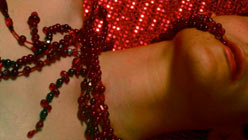If you’ve never been tempted to try out a glory hole, it might not occur to you that an art exhibition would test your virtue. Yet standing before Jonathan Solo’s Glory Hole — a wall installation of two brass handles screwed at crucifix-arm-height into the wall, and a bible with a circle cut out of its middle affixed farther down at crotch height — I felt an impulse to fit my body into the invitation, phallus-free as I am.
Slick and arty, unrepentantly derivative, and very much hands-on, curator Leo Herrera’s María: Politics, Death, Sex, Men is a visual exhibition in love with the tangible embrace of queer, male sexual practice. Not for the phobic of homo, María isn’t satisfied with acceptably distant presentations of salacious aesthetics; you must be dragged into the realm of tactile desire yourself; you must use your own body in this space.
María — which opened at Galeria de la Raza last weekend as part of QueLaCo’s Queer Latino/a Arts Festival is not the usual nominally democratic juried show we see at this event. QueLaCo called for curatorial proposals, and Herrera’s winning entry is the collaboration of a clique of artists who might represent a school of aesthetics, if their aesthetics were idiosyncratic enough. That they aren’t doesn’t harm the show. María, is not a presentation of avant garde visuals, but rather an exercise in how to make a community’s images come alive to the viewer.
As such, María offers melodramatic, yet earnest, joy. The exhibition centers around four series of photo portraits of queer youths and men. Such portraits, intended to give the hordes of abstract queerdom individuality, have become de rigueur in the community arts aesthetic; furthermore, these pieces style-check every important recent photographer from Nan Goldin to Pierre et Gilles. What’s fresh here is that the artists created their series in response to each other; “dialogue” among the works is not merely a curatorial figure of speech.
In Jody Jock’s Prayers for Children, blood and semen drawn from the bodies of adolescent boys through suicidal sexual practices (and sexual suicide practices) are represented by strings and globs of jewels. Allan Herrera’s Prayers for Children 2 fragments Jock’s Catholic images into angular mandalas, injecting pathos into digital orientalism. Robert Guzman’s more straightforward portraits of tattooed, painted, and masked young men seize the context to make a point about aspects of beauty, and hiding behind conspicuousness. On its own, the final series — a mosaic of party action shots and printed bandanas from Leo Herrera, Robert Guzman, Allan Herrera, and Keith Aguiar — would read as an anthropological study of gay nightlife. But, framed and abetted by more formal work and informed by didactic installations of Harvey Milk speeches, teenaged martyrs to homophobia, and heaps of golden poppers and condoms, the photo-mosaic acts more as a key to the rest of the exhibition.


